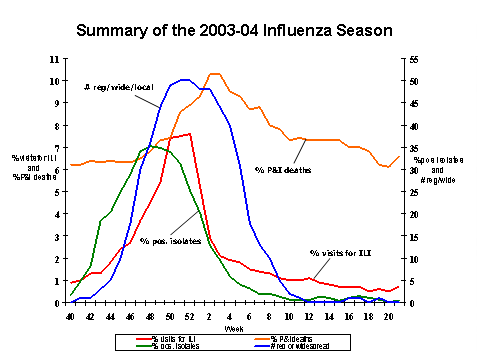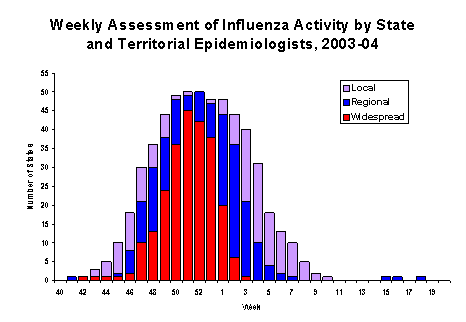Error processing SSI file
Error processing SSI file
2003 - 04 U.S. INFLUENZA SEASON SUMMARY*
Error processing SSI fileSynopsis
The 2003-04 U.S. influenza season began earlier than most seasons and was moderately severe; influenza A (H1)? A (H3N2), and B viruses co-circulated, and the predominant strain was influenza A (H3N2). This report is based on data reported by U.S. World Health Organization (WHO) and National Respiratory and Enteric Virus Surveillance System (NREVSS) Collaborating Laboratories, U.S. Influenza Sentinel Providers, U.S. State and Territorial Epidemiologists, and the 122 Cities Mortality Reporting System. Influenza morbidity peaked during early-to-mid December 2003, and pneumonia and influenza mortality peaked during early January 2004. Early outbreaks of influenza were associated with several deaths occurring among children in Texas and Colorado, and the Centers for Disease Control and Prevention (CDC) requested that states report influenza-associated pediatric deaths. In June 2004, the Council of State and Territorial Epidemiologists (CSTE) approved an initiative to add pediatric influenza-associated deaths to the list of nationally notifiable conditions.
Widespread outbreaks of avian influenza A (H5N1) among poultry
were reported in Southeast Asia in early 2004. In Vietnam
and Thailand, these outbreaks were associated with severe
human illnesses and deaths. CDC issued recommendations for
enhanced surveillance in the United States to increase the
likelihood of timely detection of an imported human avian
influenza virus infection. As of July 6, 2004, these recommendations
remain in effect and can be found on the CDC Web site at:
http://www2a.cdc.gov/han/ArchiveSys/ViewMsgV.asp?AlertNum=00204.
Laboratory Surveillance
Since September 28, 2003, WHO and NREVSS laboratories tested 130,577 specimens for influenza viruses, of which 24,649 (18.9%) were positive. Of these, 24,400 (99.0%) were influenza A viruses, and 249 (1.0%) were influenza B viruses. Of the 24,400 influenza A viruses, 7,191 (29.5%) have been subtyped; 7,189 (99.9%) were influenza A (H3N2) viruses and 2 (0.1%) were influenza A (H1) viruses. Nationwide, the percentage of respiratory specimens testing positive for influenza peaked at 35.2% during the week ending November 29, 2003; however, the largest number of isolates was reported during the week ending December 13. The peak percentage of specimens testing positive for influenza during the previous 4 seasons (1999-00, 2000-01, 2001-02, and 2002-03) ranged from 23% to 31%. Within the nine surveillance regions, the timing of peak percentages positive during the 2003-04 season ranged from the week ending November 1 in the West South Central region to the week ending December 20 in the New England, West North Central, and East South Central regions.
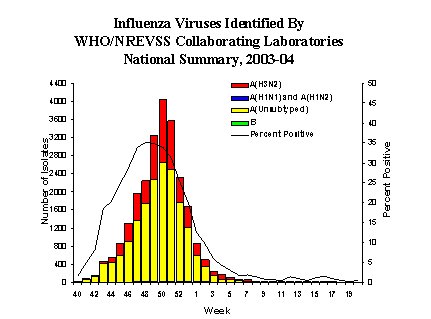
View WHO-NREVSS Regional Bar Charts | View Chart Data
Antigenic Characterization of Viral Isolates §
CDC has antigenically characterized 1024 influenza viruses collected by U.S. laboratories
since October 1, 2003: 3 influenza A (H1) viruses, 949 influenza A (H3N2) viruses, 1 influenza A (H7N2),
and 71 influenza B viruses. The hemagglutinin proteins of the influenza A (H1) viruses were similar antigenically to the hemagglutinin of the vaccine strain A/New Caledonia/20/99. Of the 949 influenza A (H3N2) isolates that have been characterized, 106 (11.2%) were similar antigenically to the vaccine strain A/Panama/2007/99 (H3N2), and 843 (88.8%) were similar to the drift variant, A/Fujian/411/2002 (H3N2).
Influenza B viruses circulating currently can be divided into two antigenically distinct lineages
represented by B/Yamagata/16/88 and B/Victoria/2/87 viruses. B/Yamagata-like viruses have circulated
widely since 1990. B/Victoria-like viruses had not been identified outside of Asia
between 1991 and 2001. However, since March 2001, B/Victoria-like viruses have been identified in
many countries, including the United States. B/Victoria-like viruses were the predominant
influenza B viruses identified in the United States during the 2002-03 season and were included in the 2002-03 and 2003-04 vaccines. During the 2003-04 influenza season, 66 of the influenza B viruses belonged to the B/Yamagata lineage and were similar antigenically to B/Sichuan/379/99. Five influenza B viruses belonged to the B/Victoria lineage and were similar antigenically to the vaccine strain B/Hong Kong/330/2001.
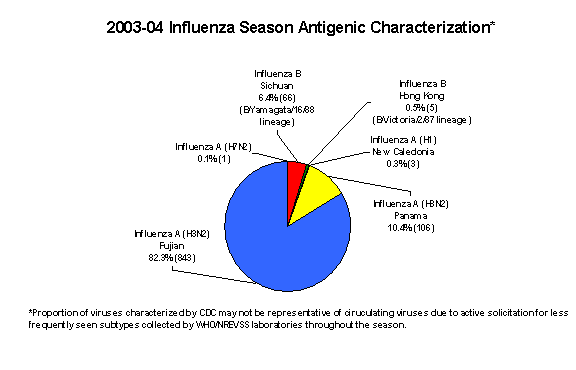
View Full Screen
Composition of the 2004-05 Influenza Vaccine:
The Food and Drug Administration's Vaccine and Related Biological Products Advisory Committee recommended that the 2004-05 trivalent influenza vaccine for the United States contain A/New Caledonia/20/99-like (H1N1), A/Fujian/411/2002-like (H3N2), and B/Shanghai/361/2002-like viruses. Both the influenza A (H3N2) and influenza B components have been updated for the 2004-05 vaccine. For the A/Fujian/411/2002 (H3N2)-like antigen, manufacturers will use the antigenically equivalent A/Wyoming/3/2003 (H3N2) virus, and for the B/Shanghai/361/2002-like antigen, manufacturers will use the antigenically equivalent B/Jilin/20/2003 virus or B/Jiangsu/10/2003 virus. These recommendations were based on antigenic analyses of recently isolated influenza viruses, epidemiologic data, and post-vaccination serologic studies in humans.
Pneumonia and Influenza (P&I) Mortality
The percentage of P&I deaths in the United States peaked at 10.3% during the
weeks ending January 10-17 and exceeded the epidemic thresholdЁ for 9 consecutive
weeks during the 2003-04 season. During the previous 4 seasons, the number of
consecutive weeks during which the percentage of deaths attributed to P&I was above
the epidemic threshold ranged from 0 to 17 weeks.
During the 2003-04 season, CDC requested that states report deaths in children < 18 years
of age who tested positive for influenza. As of May 31, 2004, 152 influenza-associated
deaths in U.S. residents aged < 18 years were reported by 40 states. All patients had
influenza virus infection detected by rapid antigen testing, viral culture, or other
laboratory methods. The pediatric data are preliminary and subject to change as more information
becomes available.
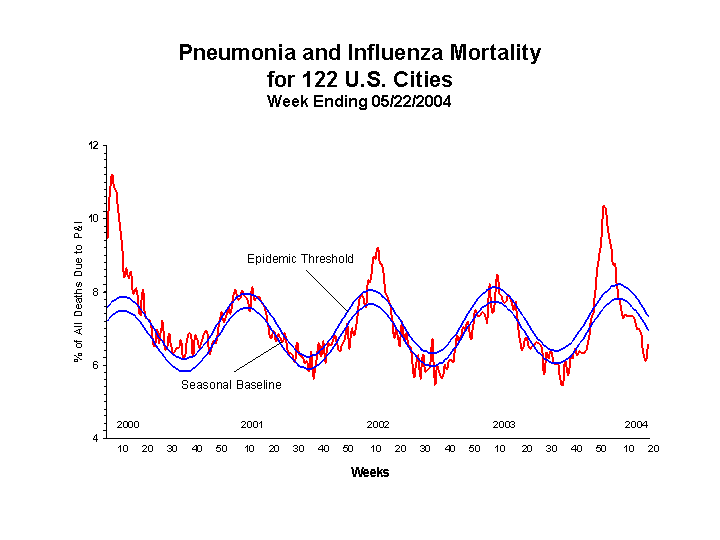
Influenza Morbidity Reports from U.S. Sentinel Sites
Nationally, influenza morbidity as reported by U.S. sentinel physicians exceeded baseline levels (2.5%)** for 9 consecutive weeks from the week ending November 15, 2003 to January 10, 2004. The peak percentage of patient visits for influenza-like illness (ILI)?/sup> was 7.6% during the week ending December 27, 2003. During the previous 4 influenza seasons, the national peak percentage of patient visits for ILI ranged between 3.2% and 7.1%唵. Regional?peak percentages of patient visits for ILI during the 2003-04 influenza season ranged from 6.7% to 10.8%. These data suggest that influenza activity peaked during late November, early December in the West South Central and Mountain regions. Influenza activity as reported by sentinel sites in the West North Central, East North Central, East South Central, Mid-Atlantic, New England, Pacific, and South Atlantic regions peaked during mid-to-late December. Appendix 1 contains region-specific data. The percentage of visits due to ILI may be higher during the week ending December 27 due to the holidays when the number of routine visits, which contribute to the denominator, is reduced.
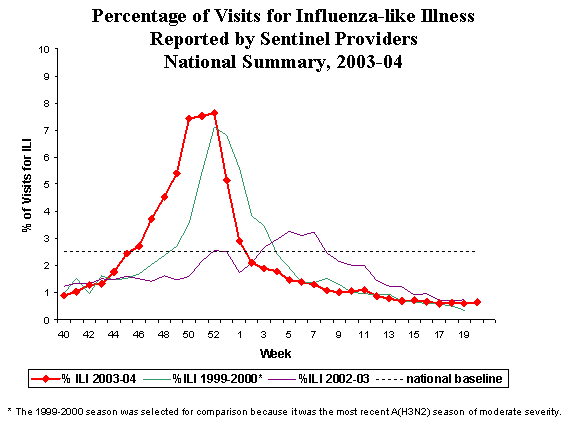
View
Sentinel Providers Regional Charts | View Chart Data
Influenza Activity as Assessed by State and Territorial Epidemiologists
The influenza activity level definitions changed for the 2003-04 influenza season to include the addition of a local activity level. In past seasons, this level of activity was most likely reported as regional influenza activity. On the basis of data from state and territorial epidemiologist reports, influenza activity?peaked during late December, when 50 states reported local, regional, or widespread influenza activity. The peak number of states reporting regional or widespread activity during the previous 4 seasons ranged from 35 to 44. During the 2003-04 season, one or more states reported local, regional, or widespread influenza activity during 23 consecutive weeks from the week ending October 11, 2003 through the week ending March 13, 2004. Widespread activity was reported by one or more states for 15 consecutive weeks from the week ending October 18, 2003 through the week ending January 24, 2004. All but one state reported widespread activity during the season.
* This summary includes data reported as of June 29, 2004. Reporting is incomplete and numbers may change as more reports are received.
?Includes influenza A(H1N1) and A(H1N2) viruses.
?The number and/or proportion of a influenza virus type/subtype may differ between the virus detections reported and the viruses antigenically characterized by CDC because 1) some isolates initially reported as influenza A (unsubtyped) through weekly surveillance may be submitted to CDC for further characterization that will include subtyping of those viruses, and 2) influenza virus types/subtypes less frequently seen during a given influenza season may be actively solicited for antigenic characterization. The number and relative proportion of virus type/subtypes reported through weekly surveillance should be considered as representative of the currently circulating viruses, whereas antigenic characterization information should be used to compare the relative proportion of a virus strain within a type or subtype.Ё The expected baseline proportion of P&I deaths reported by the 122 Cities Mortality Reporting System is projected using a robust regression procedure in which a periodic regression model is applied to the observed percentage of deaths from P&I over the previous 5 years. The epidemic threshold is 1.654 standard deviations above the seasonal baseline.
** The national 2.5% baseline was calculated as the mean percentage of visits for ILI during noninfluenza weeks plus two standard deviations. Because of wide variability in regional level data, calculating region-specific baselines is not possible and to apply the national baseline to regional level data in not appropriate.
¶ Temperature of > 100.0?F (> 37.8?C) and either cough or sore throat in the absence of a known cause.
唵 Data for percentage of patient visits for ILI weighted by state population.
嘢urveillance Regions: New England (Connecticut, Maine, Massachusetts, New Hampshire, Vermont, Rhode Island); Mid-Atlantic (New Jersey, New York City, Pennsylvania, Upstate New York); East North Central (Illinois, Indiana, Michigan, Ohio, Wisconsin); West North Central (Iowa, Kansas, Minnesota, Missouri, Nebraska, North Dakota, South Dakota); South Atlantic (Delaware, Florida, Georgia, Maryland, North Carolina, South Carolina, Virginia, Washington, D.C., West Virginia); East South Central (Alabama, Kentucky, Mississippi, Tennessee); West South Central (Arkansas, Louisiana, Oklahoma, Texas); Mountain (Arizona, Colorado, Idaho, Montana, Nevada, New Mexico, Utah, Wyoming); Pacific (Alaska, California, Hawaii, Oregon, Washington)
?Levels of activity are 1) no activity, 2) sporadic-small numbers of laboratory-confirmed influenza cases or a single influenza outbreak reported but no increase in cases of ILI, 3) local-outbreaks of influenza or increases in ILI cases and recent laboratory-confirmed influenza in a single region of a state, 4) regional-outbreaks of influenza or increases in ILI cases and recent laboratory-confirmed influenza in at least two but less than half the regions of a state, and 5) widespread-outbreaks of influenza or increases in ILI cases and recent laboratory-confirmed influenza in at least half the regions of a state.
Error processing SSI file
